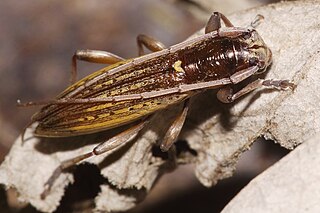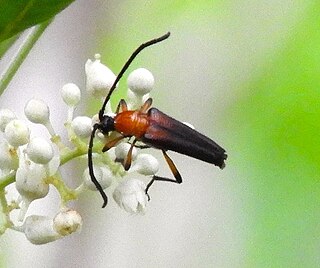
Xylotoles is a genus of flat-faced longhorns in the beetle family Cerambycidae. There are more than 15 described species in Xylotoles found mainly in New Zealand, Australia, and surrounding islands.

Sternidocinus is a genus of flat-faced longhorns in the beetle family Cerambycidae. This genus has a single species, Sternidocinus barbarus, found in California.

Trichocanonura is a genus of flat-faced longhorns in the beetle family Cerambycidae. This genus has a single species, Trichocanonura linearis, found in the southwestern United States and Mexico.

Bellamira is a genus of flower longhorns in the beetle family Cerambycidae. This genus has a single species, Bellamira scalaris, found in South America.
Charisalia is a genus of flower longhorns in the beetle family Cerambycidae. This genus has a single species, Charisalia americana, found in the eastern United States.

Cyphonotida is a genus of flower longhorns in the beetle family Cerambycidae. This genus has a single species, Cyphonotida rostrata, found in North, Central, and South America.

Neobellamira is a genus of flower longhorns in the beetle family Cerambycidae. This genus has a single species, Neobellamira delicata, found in coastal states and provinces of North America.
Orthochoriolaus is a genus of flower longhorns in the beetle family Cerambycidae. This genus has a single species, Orthochoriolaus chihuahuae, found in Arizona and western Mexico.

Metacmaeops vittata is a species of beetle in the family Cerambycidae, the only species in the genus Metacmaeops. This beetle is distributed in United States.

Bimiini is a tribe of beetles in the subfamily Cerambycinae, containing the following genera and species:

Criodion is a genus of Long-Horned Beetles in the beetle family Cerambycidae. There are about 11 described species in Criodion.

Plocaederus is a genus of Long-Horned Beetles in the beetle family Cerambycidae. This genus has a single species, Plocaederus bellator. It is known from the South American countries Brazil, Ecuador, Guyana, French Guiana, Paraguay, and Suriname.

Gracilia is a genus of longhorn beetles in the family Cerambycidae. This genus has a single species, Gracilia minuta. It is native to Europe and has been introduced to the United States, Argentina, and Uruguay.
Pseudomethia is a genus of typical longhorn beetles in the family Cerambycidae. This genus has a single species, Pseudomethia arida, found in California, Arizona, and northwest Mexico.
Liberedaxia is a genus of typical longhorn beetles in the family Cerambycidae. This genus has a single species, Liberedaxia deslauriersi, found in Utah and Arizona.

Paranoplium is a genus of longhorn beetles in the family Cerambycidae. This genus has a single species, Paranoplium gracile. It is found in the western United States and Mexico.
Phrynoeme is a genus of typical longhorn beetles in the family Cerambycidae. This genus has a single species, Phrynoeme cucullata, found in South America.
Pseudoropica is a genus of longhorned beetles in the family Cerambycidae. This genus has a single species, Pseudoropica punctatostriata, found in Madagascar.
Mimacalolepta is a genus of longhorned beetles in the family Cerambycidae. This genus has a single species, Mimacalolepta dunni, found in Papua New Guinea.

Clyzomedus is a genus of flat-faced longhorns in the beetle family Cerambycidae. There are about 10 described species in Clyzomedus.












